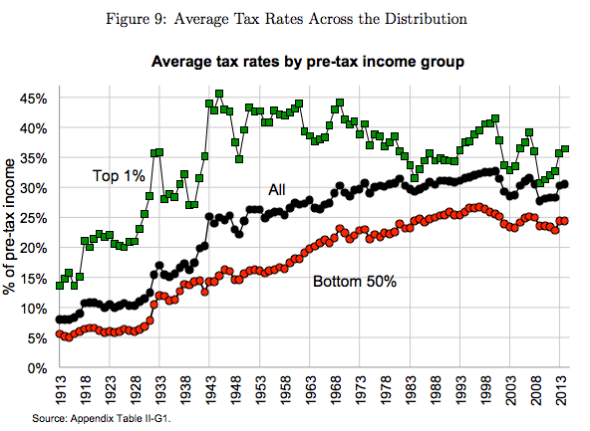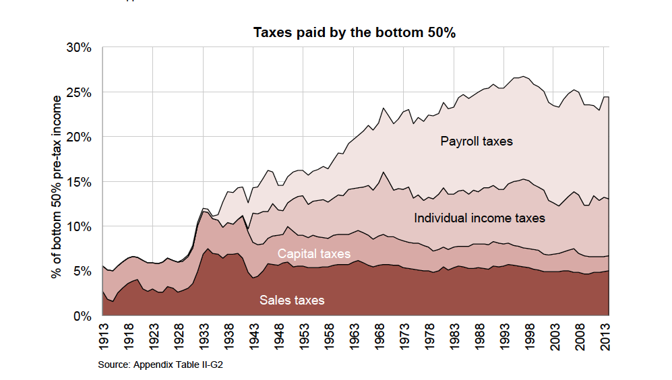In a previous item, I included a table of U.S. “top bracket marginal income tax rates” over the past century. This is the tax rate you’d pay on the next dollar of taxable income, whenever you hit the highest tax bracket.
The reason for showing the chart was as a reminder of how significantly tax policy changed about 30 years ago, with the Tax Reform Act of 1986, which was under Ronald Reagan but had bipartisan support. For more than a half-century before that change, the top-bracket rate had always been at least 50 percent, had been as high as 94 percent, and was mostly above 70 percent. Since that change, it’s been in the 30s—now at 37 percent.
The reminder, in turn, was tied to a discussion at Davos this past week, in which a leading tech entrepreneur, Michael Dell, had scoffed at the idea of imposing a 70 percent top-bracket tax rate, asking a questioner to “name one!” country where such rates had coexisted with a strong economy. The “name one” country was the mid-20th-century United States.
Of course, there are a million caveats. In 1986, part of the argument for lowering rates was to reduce the appeal of tax shelters and other loopholes, and broaden the base of income subject to taxes. The fact that the U.S. had sky-high progressive taxes during its decades of post-World War II obviously does not prove that the same rates would make sense now. Correlation is not causation. And so on.
But the historical record is worth being aware of. Now, readers with additional info and reactions.
1) What people actually paid. A reader sends this chart, from a 2017 paper by the economists Thomas Piketty, Emmanuel Saez, and Gabriel Zucman, showing who has borne the effective burden of taxation, over the decades. It’s worth looking at closely.
The chart shows average tax rates—the share of total income actually paid in taxes—rather than marginal rates. The steady increase in average taxes for the bottom 50% is driven mainly by rising payroll taxes.

The reader who sent the chart adds:
Certainly, we may need higher tax rates to pay for essential services. There is much work to be done.
That said, as you likely know, the high marginal tax rates of the past do not align with the relatively static effective tax rate that was actually paid by the wealthy due to exemptions and other changes. It is not that much lower today than it was in the 1950s. Yes, taxes might need to go up, but we shouldn't mislead people into thinking the rich actually paid more in the past.
By any reasonable standard, my family would be considered well-off. Not the 0.01 percent with Bill Gates, but likely in the top 5 percent. We are very fortunate. No, I wouldn't really want to pay higher taxes, but I realize everyone in the upper-middle class on up may need to do so to make a shared investment in our country.
It seems to me the way to truly MAGA would be to invest in the education of children from all backgrounds, work toward a greener future, welcome immigrants who are eager to join our society, and work with other nations to help alleviate human suffering all over the globe.
As a New Yorker, I love that anyone can become one by rooting for the Yankees or the Mets. One day you are from China or Jamaica, the next you are part of the fabric of the city with a shared sense of responsibility and possibility. To me, that's America. I'll climb down off my soapbox now!
2) Taxes as proxy for public investment. Another reader points to an important book on how the U.S. economy worked during its era of post-World War II growth. This is American Amnesia, by Jacob Hacker and Paul Pierson. The reader says:
I wanted to point out that it would be useful to consider the work of Yale's Jacob Hacker, who shows that the U.S. economy was the most productive when the top tax rates were what now seems like very high levels. His thesis is that the high rates signified that the levels of government expenditure/investment was also high, which he argues drives overall economic growth. He points out that economic growth performed the best when tax rates were high and unions were strong….
Nuance doesn't seem to work, especially in this day and age, so from a political perspective, if I were advising the democrats, I'd go for the OC pitch that I would slap a high rate on income over $10 million/year. There would be the usual socialist tag bandied around, but I suspect even many republicans would think that once you were raking in $10 million in one year, taxing any amount over that would seem fair.
In their book, Hacker and Pierson write about the change in the Republican party’s attitude toward taxes, starting with the “Contract with America” under which Newt Gingrich won GOP control of the House in the 1994 mid-term elections:
From 1994 on, a simple principle seemed to dictate GOP tax stances: the more a particular tax fell on the wealthiest Americans, the more important it was to cut it. Both Reagan and George H.W. Bush had signaled that a progressive tax code remained a priority and, in 1986 and 1990, had supported tax packages based on that principle. But after the Gingrich revolt, Republicans focused increasingly on tax cuts for the highest income groups—cuts in the estate, dividends, and capital gains taxes, as well as the top marginal income tax rate. They did so even though public opinion polls have indicated consistently that voters’ biggest complaint about the federal tax system is that the rich do not pay their fair share.
3) A different view on “fair share.” On the other hand, from another reader:
Michael Dell was right… It isn't as simple as that, and it is misleading to point back to the earlier decades to make this claim—unless of course if a new 70 percent bracket today would be effectively the same as back then (allowing for all of the loopholes, caps, etc.), but then what's the point of that other than politics?
Of course, if the new 70 percent bracket would not have all of those loopholes, etc. leading to an actual effective tax rate of ~70 percent, then Dell's question would come back - "Show me where that has worked before"...
Related to this topic, it is such as shame when politicians (and others) make the statement like "It's time that they pay their fair share" (referring to the "rich"). We all know that the vast majority of taxes are paid by 15-20 percent of the taxpayers. Fifty percent of the citizens pay $0. It's playing off/creating a "victimhood" mentality, which ultimately is bad for our country (but good for political points in the short term).
For the record, the “50 percent of the citizens pay $0” claim requires assuming away the largest tax that lower-income households pay, namely the payroll tax. The paper by Piketty, Saez, and Zucman shows that in fact the lower 50% of households pay not $0 but rather about a quarter of their total income in taxes:

4) “Very best part of our history.” Finally for today, from another reader, in the Midwest:
Today’s pundits who are raving about the mad socialists (Warren and Ocasio-Cortez) who they claim are trying to destroy our country have never read any economic history, and no doubt would have forgotten if they had actually read about earlier tax policies.
We need more folks to remind us about the time most mature Americans feel was the very best part of our history (post second war) and the reasons for our economic growth and stability during that period.